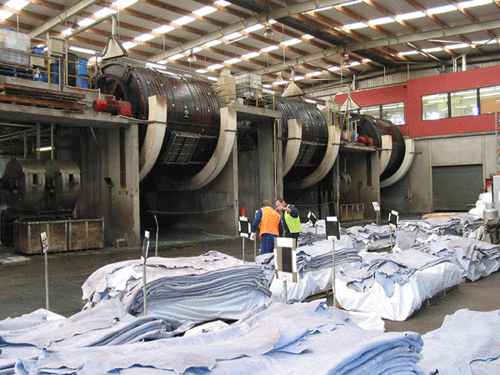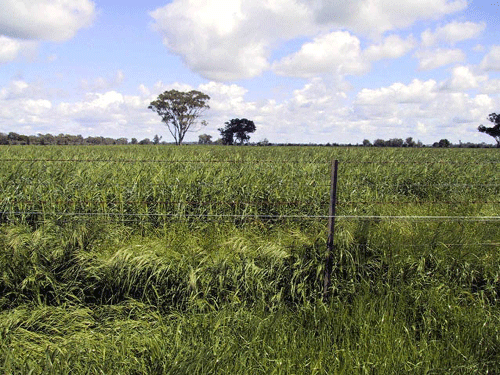Tanning waste minimisation processes
When CSIRO Leather Research started in the Division of Protein Chemistry in 1965, tannery processes were similar to those used since the 1940s. All hides used had been preserved by salting and the subsequent tanning process required very high water and chemical usage with all of the effluent discharged to the sewer without treatment.
Over the next 40 years (1965-2005) CSIRO scientists led by Jim Scroggie and Catherine Money developed waste minimisation processes for the leather industry. These were: short-term preservation and green processing; Direct Chrome Liquor Recycling; hair-saving unhairing and carbon dioxide deliming. Many researchers were involved in the development of these processes which have enabled the industry to be environmentally and economically sustainable.
It has been difficult for Australian tanneries to survive in the 21st century but those still in operation are using CSIRO processes. In the production of wet-blue leather in Australia now, full thickness unsalted hides are unhaired (with hair-saving not hair-degradation), CO2 delimed, pickled and chrome tanned with recycled liquors. CSIRO clean technologies are used for each of these processes. Consequently, Australian hide tanneries are world leaders in wet-blue production and compared to the rest of the world, have the lowest water consumption and the least polluting, low-salt effluents.
Catherine Money was invited to give the two most prestigious awards in leather research internationally. These were the John Arthur Wilson Memorial Lecture for the American Leather Chemists Association in 1991 and the Procter Memorial Lecture for the Society of Leather Technologists and Chemists, UK in 1995. In 2009 she was named, as the top leather scientist in the world post 1970, in an article in the journal Leather International.
The situation in the 1960s
In 1965, tannery processes were similar to those used since the 1940s and were inefficient and environmentally unsatisfactory. All hides processed had been preserved by salting and this salt had to be removed by soaking at the tannery before further processing. The hair was removed from the hides by degrading it with lime and sulfides. Once the hair was destroyed, large amounts of ammonium salts were used for deliming, hides were pickled with salt and acid and then chrome tanned or in some cases vegetable tanned. After tanning, most leathers were further processed to finished leather. Water and chemical usage was very high. All the effluent was discharged to sewer without treatment. Now there is very little finished leather produced in Australia but wet-blue is exported. Wet-blue is the term for a hide which has been unhaired, chrome-tanned and left wet; it can be stored and exported in this state.
Green processing and short term preservation
By processing green, unsalted hides and skins, the cost of salting is eliminated and the Total Dissolved Solids (TDS) in the effluent is greatly reduced. Processing hides near their source, at least to wet-blue, is best for the environment.
All Australian hides and skins were salted until CSIRO’s short-term preservation methods for hides were developed by Catherine Money to facilitate green processing. Low levels of sodium chlorite proved to be the best chemical system and were adopted in the early 1970s. It is still being used in 2010 but chilling is now usually preferred for preservation of hides during transportation and storage before green processing. Where hides are sourced close to the tannery, no preservation is needed.
Green hides are green fleshed before processing. In Australia, green fleshings amount to about 30% of hide weight and the fleshings and trimmings are rendered at the meatworks to produce high quality meat meal and tallow as valuable co-products.

Direct Chrome Liquor Recycling
Trivalent chromium is still the most versatile and commonly used tannage. For Direct Chrome Liquor Recycling (DCLR), the spent chrome liquor is used as the next pickle liquor, after the addition of acids and salt. Any excess liquors are collected for chrome recovery by precipitation. The recovered chrome can be redissolved in acid and added to the chrome recycle liquors. DCLR significantly reduces the use of both sodium chloride and chromium sulphate. DCLR has sometimes been referred to as SiroChrome.
Since the comprehensive studies of DCLR by Jim Scroggie and Margaret Davis in the 1970s, which they later reviewed in 1980, Australian tanneries have successfully adopted this system and are still achieving considerable cost savings, and reductions in effluent chromium and salinity. Good practice allows indefinite re-use of the chrome liquor. Salinity levels in the effluent resulting from DCLR are far lower than in conventional high exhaustion processes or chrome precipitation and reuse systems. This is very important in Australia.
Hair-saving unhairing
In conventional unhairing of hides, called liming, the hair is degraded with lime and sulphides and is discharged for effluent treatment. The original Sirolime process developed in the early 1980s by Scroggie, Cranston and Davis showed that hair could be removed from hides by using conventional reagents in a novel way. It consisted of an impregnation stage with hydrosulfide and then a brief wash followed by oxidation of hydrosulfide external to the hide. Lime was then added and hair loosening occurred due to localised attack on the hair roots by the sulfide ions generated within the hide. The hair could be recovered by filtration.
This process was developed with salted hides but did not give satisfactory hair recovery with green (unsalted) hides and the process was modified by Robin Cranston and Catherine Money. It was subsequently further modified to eliminate the impregnation step because the multi-stage process was too time-consuming. Alkaline treatment of hides changes cystine in hair keratin to lanthionine and lysinoalanine making the hair resistant to sulphide hydrolysis. This reaction is known as immunisation of hair. Drumming for one hour with hydrosulfide plus lime causes partial immunisation and further hydrosulfide or sulfide is added to remove fibrous hair.
This process was adopted by Australian tanneries in the late 1980s and the hair has since been used as a slow release high organic nitrogen fertiliser. Effluent loads and sludge volumes were greatly reduced. The CSIRO processes did not use proprietary products. Now most chemical supply companies have developed hair saving processes which use a variety of proprietary products. All the processes rely on partial immunisation of the hair. Critical factors in a successful process are the use of a reducing agent such as hydrosulfide, the amount of alkali and the time and temperature of immunisation. Due to the major environmental benefits, hair saving unhairing processes have been widely adopted around the world.

Carbon dioxide deliming
After unhairing, the hides are delimed to remove the alkalinity which results from the unhairing process. Traditionally ammonium salts were used for deliming. The CSIRO carbon dioxide deliming process for full thickness hides was developed and implemented by White, Money, Poole and Karamoshos in the early 1990s. It was quickly adopted by tanneries, as it reduced chemical costs and lowered ammonia and nitrogen in the effluent. In other countries, hides are usually split before deliming and CO2 can be used more easily for thin hides.
Beneficial irrigation with tannery effluent
Australian tanneries have significantly lowered the total dissolved solids (TDS) discharged mainly by processing green rather than salted hides and by Direct Chrome Liquor Recycling. An Australian tannery processing 20 000 tonnes of hide a year saves over 7 000 tonnes of salt.
These tanneries can sustainably use the effluent for irrigation. Many components of the TDS are beneficial but the application rate is critical. There must be sufficient suitable land available and it must be managed as a farm. The tannery effluent and hair are replacing fertilisers.

The XIX International Congress of the International Union of Leather Technologists and Chemists Societies
In 1987, Australia hosted the XIX International Congress of the International Union of Leather Technologists and Chemists Societies (IULTCS) in Melbourne, the first time such a Congress had been staged in the Asia-Pacific region. This biennial Congress is the major world scientific forum for leather science and technology and is keenly sought by member countries associated with the IULTCS. The Melbourne Congress was planned and run by a small committee chaired by Jim Scroggie and comprising members from the Division’s Leather Research Program and industry personnel. It was an outstanding success attracting universal acclaim from the more than 400 participants from over 20 countries. A number of innovations into the way of running the Congress were introduced that became a model for future conferences.

Economic impact
CSIRO worked closely with tanneries in developing the new processes and Leather Research staff did full-scale trials in tanneries and assisted with process implementation. Problems always occurred during implementation but were overcome and processes were improved.
In 2010 there were five wet-blue tanneries operating in Australia. These are:
- New Wave Leathers, Toowoomba, QLD
- Casino Hide Tanners, Casino, NSW
- Gunnedah Leather Processors, Gunnedah, NSW
- Walfertan Processors, Aberdeen, NSW
- Geelong Leather, Culcairn, NSW.
The other tannery in Australia is Packer Leather, Narangba, QLD, which produces excellent finished kangaroo leather from frozen, unsalted skins. For them the most important liquor recycling processes are water reduction and reuse and CO2 deliming. Hair saving does not work for kangaroo fur.
All Australian wet-blue tanneries use the CSIRO processes. The Culcairn tannery was started by Michell leather in 1991 and was built because of the availability of CSIRO’s water saving technologies. Catherine Money was involved in assisting them gain approval for the development which used water and salt minimisation processes.
Direct Chrome Liquor Recycling and CO2 deliming for full thickness hides were quickly adopted because there were immediate, significant chemical cost savings. Short term preservation was also quickly adopted because it facilitated green processing rather than salting which also gave significant financial benefits. In 1980, DCLR saved 30c per hide in chemical costs. In 2001, it was estimated by tanners and CSIRO that wet-blue tanneries made the following annual savings from processes: hair saving unhairing, $1m ; CO2 deliming, $1.5m. Four wet-blue tanneries in NSW and one in Queensland are still in existence because they use these processes. All the processes were developed for Australian requirements and some of them have been adopted in other countries.

The hair saving unhairing has had the greatest world impact and as mentioned above, various processes which are based on Jim Scroggie’s invention are now in use. Any wet-blue tannery claiming to be environmentally responsible uses a hair-saving process.
Initially, the Australian industry contributed substantially to CSIRO for Leather Research and developments were implemented in tanneries without charge. Later the Meat Research Council / Meat & Livestock Australia (MRC/MLA) funded projects and the aim was to have developments adopted by industry. In the 1990s, tanners paid a fee for implementation of CO2 deliming.
Source
- Money CA, 2010, Personal communication.
